Idiographic and Nomothetic Approaches in Personality Psychology
Personality psychology is the study of individual differences—what makes each person unique—and the commonalities that characterize groups of people. In addressing these questions, psychologists use two main approaches: the idiographic and nomothetic approaches. Each approach offers a different lens for understanding personality, focusing on either the uniqueness of the individual or the general principles that can be applied across populations.
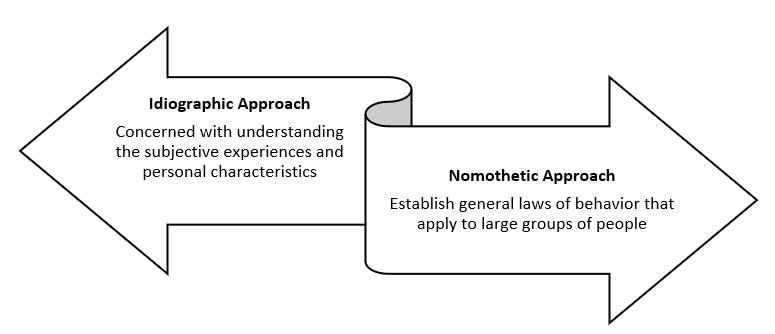
Approaches to Personality
Idiographic Approach in Personality Psychology
The idiographic approach emphasizes the unique, individual aspects of personality. This approach is concerned with understanding the subjective experiences and personal characteristics that make each person distinct. Derived from the Greek word “idios,” meaning “private” or “personal,” the idiographic method focuses on in-depth, qualitative analysis of individuals rather than broad, quantitative generalizations. It seeks to capture the richness of human experience, arguing that no two people are exactly alike.
Qualitative Methods in the Idiographic Approach
The idiographic approach relies heavily on qualitative research methods. Techniques such as open-ended interviews, case studies, and participant observation are commonly used to gather detailed data on individuals’ thoughts, feelings, and experiences. The goal is not to generalize findings to a larger population but to understand the complexity of the individual in question.
One well-known example of the idiographic approach is Sigmund Freud‘s (1909) use of the case study method in psychoanalysis. Freud’s analysis of cases like “Little Hans” provided rich, detailed insights into the unconscious mind, using techniques such as free association to explore patients’ thoughts and feelings without the constraints of structured, quantitative methods. Freud’s emphasis on the unique inner world of each individual epitomized the idiographic approach, as he focused on understanding how personal history, emotions, and unconscious desires shaped behavior.
Freud’s method, although revolutionary, faced criticism for its subjectivity. His reliance on unstructured techniques and retrospective analysis raised concerns about bias and reliability. However, his work laid the groundwork for humanistic psychologists, who also embraced the idiographic approach. Carl Rogers, for instance, emphasized the importance of understanding each person’s subjective experience in his person-centered therapy, arguing that individuals must be viewed holistically to truly grasp their behavior.
The Case Study Method
Case studies are a primary tool in the idiographic approach, offering a deep dive into an individual’s life and personality. This method involves gathering extensive data over a long period, allowing researchers to develop a nuanced understanding of a person’s traits, behaviors, and motivations. Gordon Allport (1961) was a significant advocate of the idiographic approach and coined the term. He argued that case studies provide insights that cannot be gleaned from studying large groups of people. Allport believed that personality tests that yield quantitative data lack the depth needed to understand individual uniqueness. His work emphasized that idiographic studies offer a complete, global understanding of personality, capturing what makes each person special.
For example, Allport’s analysis of letters written by a young woman named Jenny offered a window into her unique personality. He identified specific traits that could not be generalized to a broader population, thus highlighting the limitations of nomothetic approaches in capturing the intricacies of individual lives.
Advantages of the Idiographic Approach
- Rich, Detailed Understanding– Provides an in-depth exploration of an individual’s unique personality, thoughts, and experiences. It is useful for gaining a nuanced understanding that goes beyond surface-level traits.
- Application in Clinical Settings– Valuable for developing personalized treatment plans in psychotherapy or counseling. It helps therapists tailor interventions based on a client’s specific background, history, and personality.
- Exploration of Rare or Exceptional Cases– Particularly useful for studying individuals with uncommon psychological conditions or experiences. It allows psychologists to gain insights from cases that may not fit into general models of behavior (e.g., rare mental health disorders).
- Holistic View of Personality– Provides a more comprehensive understanding of an individual, factoring in subjective emotions, motivations, and internal experiences. It avoids reducing a person to statistical data or predefined categories.
Limitations of the Idiographic Approach
- Difficulty in Generalizing Findings– Since it focuses on single individuals or small groups, the findings are difficult to generalize to broader populations. It limits its applicability to developing universal psychological theories or laws.
- Lack of Standardized Measures– The approach often relies on subjective, qualitative data, such as interviews or personal observations, which can vary widely between studies. Without standardized tools, it can be hard to compare findings across different cases.
- Challenges with Reliability and Validity– The subjective nature of the data collected may lead to issues with reliability (consistency of results) and validity (accuracy of results). This can make it difficult to ensure that findings are scientifically sound or replicable.
- Criticism of Scientific Rigor– Critics argue that the idiographic approach lacks the scientific rigor found in nomothetic research, where hypotheses are tested in controlled, repeatable conditions. The method’s qualitative focus may be seen as less objective and not as suitable for developing broad psychological theories or models.
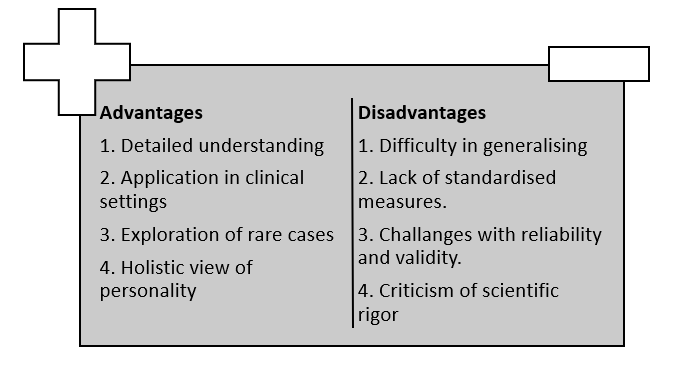
Advantages and Limitations
Nomothetic Approach in Personality Psychology
In contrast to the idiographic approach, the nomothetic approach seeks to establish general laws of behavior that apply to large groups of people. This approach assumes that human behavior is governed by universal principles, which can be identified through the study of large samples. The term “nomothetic” is derived from the Greek word “nomos,” meaning “law,” reflecting the approach’s focus on discovering generalizable truths.
Quantitative Methods in the Nomothetic Approach
The nomothetic approach relies on quantitative methods, such as experiments, surveys, and psychometric tests, to gather data from large groups of individuals. These methods allow researchers to identify patterns of behavior that can be applied across populations, generating universal principles of personality.
A classic example of the nomothetic approach is Hans Eysenck’s (1970) work on personality traits. Eysenck used factor analysis to identify broad dimensions of personality, such as extraversion and neuroticism, that could be measured across individuals. He developed the Eysenck Personality Questionnaire (EPQ), which categorized individuals based on their scores along these dimensions, allowing for quick and efficient classification of personality types. Eysenck’s work exemplifies the nomothetic approach, as it sought to create a universal framework for understanding personality that could be applied to large populations.
The use of standardized tests, such as the Big Five Personality Test, is another example of the nomothetic approach. This test measures individuals on five broad personality traits—openness, conscientiousness, extraversion, agreeableness, and neuroticism—providing a quantifiable way to compare individuals across a common set of dimensions.
Biological and Behavioral Approaches
The nomothetic approach is often associated with biological and behavioral theories, which seek universal explanations for human behavior. For instance, research into the “fight or flight” response, initially believed to be a universal reaction to stress, is an example of the nomothetic approach in action. Studies have shown that this response is governed by the autonomic nervous system and is common across species, suggesting a general law of behavior.
However, research by Taylor et al. (2000) challenged the universality of the “fight or flight” response, showing that women may exhibit a “tend and befriend” response to stress instead. This finding highlights a limitation of the nomothetic approach: while it seeks to identify universal principles, it can sometimes overlook individual differences and gender-specific responses that the idiographic approach captures more effectively.
Advantages of the Nomothetic Approach
- General Laws of Behavior– Identifies universal principles that can be applied across populations, enabling psychologists to predict behaviors.
- Broad Applicability– Useful for developing interventions and treatments that work for a wide range of individuals, such as drug therapies for mental health conditions.
- Reliability and Validity– Reliance on quantitative data enhances the scientific rigor of research, making findings more replicable and generalizable.
Limitations of the Nomothetic Approach
- Overlooks Individual Differences– General principles may not account for unique psychological experiences, leading to interventions that are ineffective for some individuals.
- Reductionism– The focus on quantitative data can reduce complex personalities to mere scores, failing to capture the richness and depth of individual human experiences.
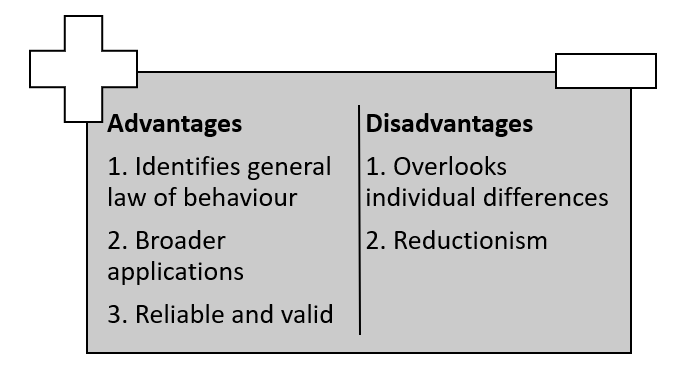
Advantages and Disadvantages
Case Analysis: Idiographic vs. Nomothetic Approaches in the Study of “Rahul”
Consider a hypothetical case study of a man named Rahul, a 35-year-old individual who struggles with anxiety and perfectionism. This example will showcase how the idiographic and nomothetic approaches could be applied to his personality and psychological issues.
Idiographic Approach
The idiographic approach focuses on understanding Rahul’s unique experiences, traits, and psychological patterns. In this approach, a psychologist might explore Rahul’s personal history, relationships, emotional world, and the specific contexts that contribute to his perfectionism and anxiety.
- Case Study Method- The therapist uses qualitative methods like in-depth interviews and diaries to explore Rahul’s thoughts, feelings, and behaviors. Through this process, it is revealed that Rahul’s anxiety stems from childhood experiences of being excessively criticized by his parents for small mistakes. His perfectionism developed as a defense mechanism to gain their approval and avoid criticism. In Rahul’s case, the recurrent criticism in childhood led to deeply ingrained beliefs that he must be flawless to be accepted by others. The therapist identifies that his self-worth is tied to external validation, which fuels his anxiety.
- Personalized Treatment- With the idiographic approach, treatment is highly personalized. The therapist may develop a psychodynamic treatment plan, addressing Rahul’s unresolved emotional conflicts from childhood and helping him reformulate his beliefs around self-worth. Techniques like free association and dream analysis could be employed to uncover unconscious memories and emotions that are driving his perfectionism.
Strengths of Idiographic Approach–
- Rich Exploration: The therapist gains a deep, detailed understanding of Rahul’s unique struggles and the subjective meaning behind his behaviors.
- Tailored Intervention: By focusing on Rahul’s individual background, the therapist is able to craft a treatment plan that directly addresses his personal experiences and triggers.
Limitations of Idiographic Approach–
- Limited Generalization: While the insights about Rahul’s personality are profound, they are specific to his life and cannot easily be generalized to others with similar issues.
- Subjective Data: The data gathered from interviews and personal reflections may lack scientific rigor and can be influenced by bias or memory distortions.
Nomothetic Approach
A psychologist applying a nomothetic approach would look at Rahul’s perfectionism and anxiety in the context of general psychological theories and standardized assessments. The goal would be to understand how Rahul fits into broader patterns of personality and behavior.
- Standardized Personality Tests- Rahul might complete nomothetic assessments such as the Big Five Personality Test or the Eysenck Personality Questionnaire to determine where he falls on universal personality dimensions. These tests could reveal that Rahul scores high on neuroticism (a tendency to experience negative emotions) and conscientiousness (a preference for order, responsibility, and perfectionism). His anxiety and perfectionism are seen as expressions of common traits that have been well-studied in psychology.
- General Interventions- Based on Rahul’s scores on these personality assessments, a psychologist might recommend evidence-based treatments that are known to work for people high in neuroticism and conscientiousness. For example, Cognitive Behavioral Therapy (CBT) could be used to help Rahul challenge and change the rigid thought patterns that contribute to his perfectionism. CBT would be focused on addressing automatic thoughts, such as “If I make a mistake, people will reject me,” and replacing them with more balanced thinking.
Strengths of Nomothetic Approach–
- Broad Application: This approach allows psychologists to apply general laws of behavior and established interventions that have been proven effective across large populations.
- Scientific Rigor: The use of standardized tests and quantitative data provides a higher level of reliability and validity, making it easier to replicate findings and apply them to other individuals with similar personality traits.
Limitations of Nomothetic Approach–
- Lack of Personalization: While the nomothetic approach helps identify broad patterns, it may overlook individual nuances in Rahul’s experiences and personality, such as the specific childhood experiences that led to his perfectionism.
- Reductionism: Reducing Rahul’s complex personality to scores on a test can oversimplify his psychological issues, potentially missing important factors unique to his life.
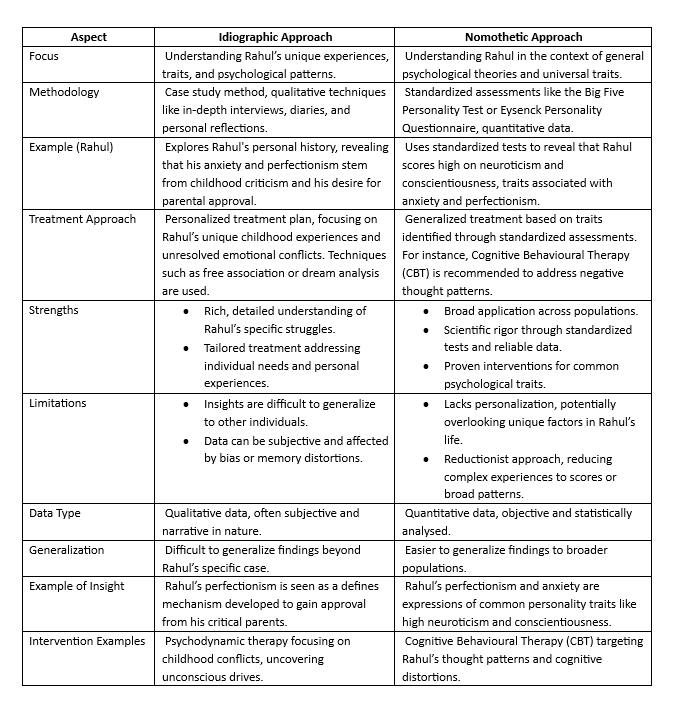
Case Analysis
Integration of Idiographic and Nomothetic Approaches
Many psychologists now advocate for an integrative approach that combines idiographic and nomothetic methods. For example, in clinical practice, a therapist might use nomothetic tools, such as standardized tests, to assess a patient’s general psychological functioning, while also employing idiographic methods, such as in-depth interviews, to explore the patient’s unique experiences and personal history. This approach allows for a more holistic understanding of the individual, combining the strengths of both perspectives.
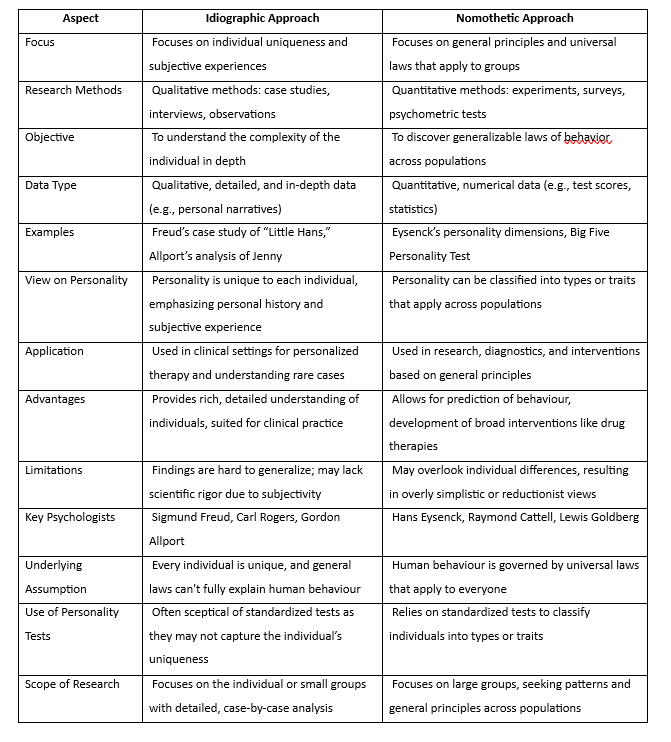
Approaches to Personality
Conclusion
The idiographic and nomothetic approaches offer two distinct, yet complementary, methods for studying personality. The idiographic approach emphasizes the uniqueness of the individual, providing rich, detailed insights into personal experience. In contrast, the nomothetic approach seeks to identify general laws of behavior that can be applied across populations. Both approaches have their advantages and limitations, and their integration offers a more complete understanding of personality. As personality psychology continues to evolve, the interplay between these two perspectives will remain central to the field.
References
Allport, G. W. (1961). Pattern and growth in personality. Holt, Rinehart & Winston.
Cardwell, M., & Flanagan, C. (2016). Psychology A level: The complete companion student book (4th ed.). Oxford University Press.
Eysenck, H. J. (1970). The structure of human personality (3rd ed.). Methuen.
Freud, S. (1909). Five lectures on psychoanalysis. Norton.
Taylor, S. E., et al. (2000). “Biobehavioral responses to stress in females: Tend-and-befriend, not fight-or-flight.” Psychological Review, 107(3), 411-429.
Subscribe to Careershodh
Get the latest updates and insights.
Join 16,594 other subscribers!
Niwlikar, B. A. (2022, March 2). Idiographic and Nomothetic Approach- Discover 2 Insightful Approaches to Personality. Careershodh. https://www.careershodh.com/idiographic-and-nomothetic-approach/
